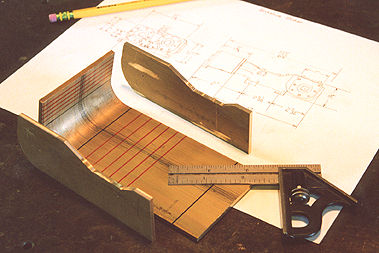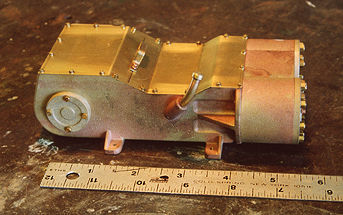
Dummy Stoker Engine
Here we have the start of the dummy stoker engine. Just some
1/8" brass so far.

Dummy Stoker
Partially completed stoker engine, fitting the sheet metal lid.

Stoker Engine
Here we have the completed stoker engine. Isn't it amazing what
you can do with some brass and a little silver solder. One thing
you can do when simulating a casting and you want some texture
is to go over your work piece with a dull center punch and then
sand blast it with some coarse sand. Even though this is just
a dummy stoker engine it actually serves a purpose on the Berkshire,
it hides the left-hand injector, as the full size engine had
no injector on this side. The injector is tucked up into the
stoker engine, and the delivery line comes out where the stoker
exhaust would be. On the full size Berkshire there is a large
exhaust line running from the stoker forward and disappears behind
the Worthington hot water pump, just perfect for an injector
delivery line.

Running Board Supports
Modern steam had many examples of the pattern maker, and foundry
mans skill. One example on the Berkshires was the running board
supports. These were very complicated castings that had brackets
for the air tanks, assorted plumbing, and on one, there is a
platform for part of the original screw type power reverse. As
making patterns for these parts is beyond my abilities they were
fabricated from brass. There are six of them and they are all
different with many little bits to solder together. This photo
shows the mounting pads that fit against the boiler.

Running Board Supports
Boiler mounting pads.

Running Board Supports
Here we are silver soldering the upper mount to the main body
of the support. When soldering complicated assemblies like this,
flux everything and put it together with little screws that can
be filed off later. Always solder on a piece of fire brick, not
on a steel work table. A steel work table will wick all the heat
out of your work piece.

Running Board Supports
Completed support with plumbing clamps.

Running Board Supports
Here we have all six running board supports representing about
sixty hours of work. Large modern steam is festooned with little
bits of jewelry like this, and it just seems to go on and on.

Low Water Alarm
Nickel plate Berkshires had a Nathan low water alarm mounted
on top of the boiler. Here we have the beginning's of one.

Low Water Alarm
Low water alarm pieces ready for assembly. The parts that represent
castings have been sand blasted with coarse sand.

Low Water Alarm
Completed low water alarm. It's
very interesting how these alarms worked. They mounted to the
top of the boiler with a pipe from the left end entering the
boiler vertically and extending down to minimum water level.
As long as water covered the bottom of this pipe, the upper horizontal
tube of the low water alarm would fill with condensate. If the
water in the boiler fell below the bottom of the vertical pipe,
the condensate would drain from the alarm allowing the horizontal
tube to fill with steam. When this happened it caused the horizontal
tube to heat up and expand. As the metal rod under the tube didn't
expand, it caused the lever connecting them to push down the
plunger at the lower right, opening a valve that blew a whistle
in the cab. A friend of mine who has a lot of experience with
full size stationary boilers said they had exactly the same alarm,
but that instead of blowing a whistle, it turned on the feed
water pump.
{BACK}
copyright
© 2004-2006, Jack Bodenmann, all rights reserved.